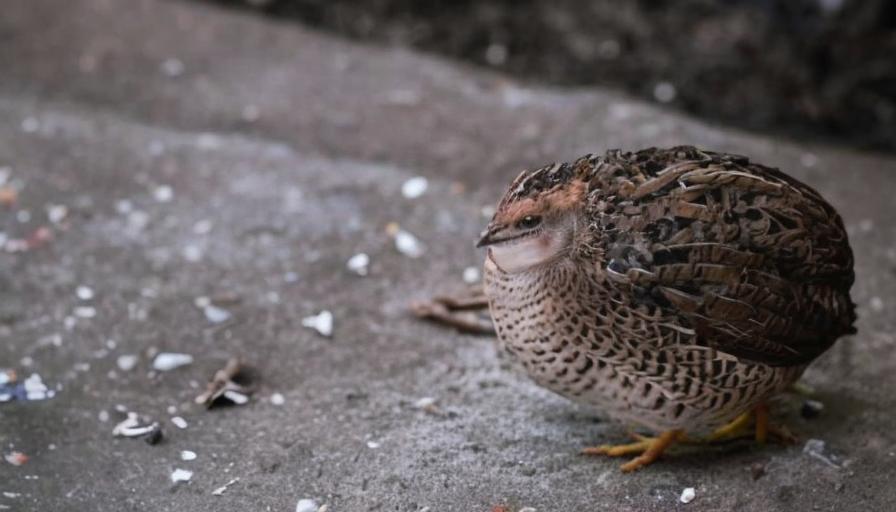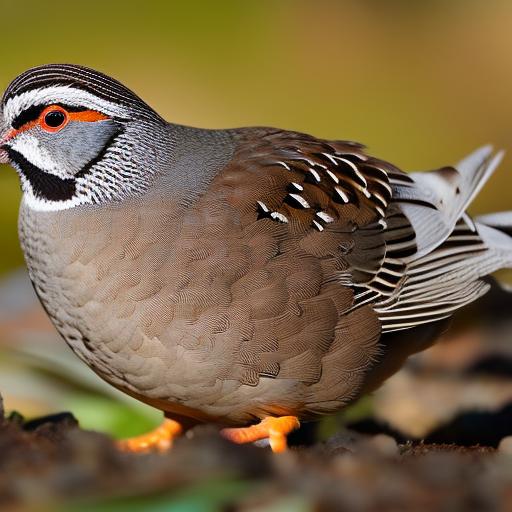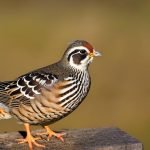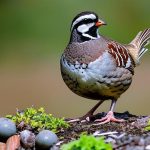Gambel quail, also known as desert quail, are small ground-dwelling birds native to the southwestern United States and parts of Mexico. These birds are known for their striking plumage, with males sporting a black face and throat, a chestnut crown, and a blue-gray body, while females have a more subdued brown and gray coloration. Gambel quail are popular game birds and are also kept as pets due to their charming personalities and relatively low maintenance requirements.
Gambel quail are social birds that thrive in small flocks, making them a delightful addition to a backyard aviary or a large indoor enclosure. They are known for their distinctive “chi-ca-go” call, which can be heard throughout their natural habitat. These birds are ground-dwellers and are not known for their flying abilities, so they require a spacious and secure enclosure to keep them safe and happy. With the right care and attention, Gambel quail can live up to 5-7 years in captivity, making them a long-term commitment for potential pet owners.
Key Takeaways
- Gambel quail are small, ground-dwelling birds native to the southwestern United States, known for their distinctive plume and colorful markings.
- When housing Gambel quail, it’s important to provide a spacious enclosure with plenty of hiding spots and perches to mimic their natural habitat.
- A balanced diet for Gambel quail includes a mix of seeds, grains, greens, and insects, along with access to grit for digestion.
- Regular health check-ups and access to a qualified avian veterinarian are essential for maintaining the well-being of Gambel quail.
- Socialization and enrichment activities, such as dust baths and foraging toys, are crucial for keeping Gambel quail mentally and physically stimulated in captivity.
Housing and Enclosure for Gambel Quail
When it comes to housing Gambel quail, it’s important to provide them with a spacious and secure enclosure that mimics their natural habitat. A large outdoor aviary with plenty of ground space is ideal for these birds, as it allows them to forage, dust bathe, and socialize with their flock mates. The aviary should be constructed with sturdy wire mesh to prevent predators from gaining access and should also have a solid roof to protect the quail from aerial threats.
For those who prefer to keep Gambel quail indoors, a large custom-built enclosure with a solid base and ample floor space is essential. The enclosure should be furnished with natural substrates such as sand or soil to allow the quail to exhibit natural behaviors like scratching and dust bathing. Providing hiding spots and perches will also give the quail a sense of security and enrichment. It’s important to regularly clean the enclosure and provide fresh bedding to maintain a healthy environment for the quail.
Diet and Nutrition for Gambel Quail
Gambel quail are omnivorous birds that require a varied diet to thrive in captivity. In the wild, they feed on a combination of seeds, insects, and vegetation, so it’s important to replicate this diet in a captive setting. A high-quality game bird feed can serve as the base of their diet, supplemented with fresh greens, fruits, and vegetables. It’s important to offer a mix of seeds such as millet, sunflower seeds, and cracked corn to ensure they receive the necessary nutrients.
In addition to seeds, Gambel quail should have access to live insects such as mealworms or crickets, which provide essential protein and enrichment. Fresh water should be available at all times, provided in shallow dishes to prevent drowning. It’s important to monitor the quail’s food intake and adjust their diet as needed to maintain a healthy weight and overall condition. Providing access to grit or small stones will also aid in digestion by helping the quail grind up their food in their gizzards.
Health and Veterinary Care for Gambel Quail
Maintaining the health of Gambel quail requires regular observation and preventive care. It’s important to monitor the quail for any signs of illness or injury, such as lethargy, loss of appetite, or abnormal droppings. Any changes in behavior or appearance should be promptly addressed by a qualified avian veterinarian. Routine health checks are also recommended to ensure the overall well-being of the quail.
In addition to regular veterinary care, it’s important to provide a clean and hygienic environment for the quail. This includes regular cleaning of the enclosure, providing fresh bedding, and ensuring that food and water dishes are kept clean and free of contamination. Preventing parasites such as mites and lice is also essential for maintaining the health of Gambel quail. Regular inspections of the birds and their environment can help identify any potential issues before they become serious health concerns.
Socialization and Enrichment for Gambel Quail
Gambel quail are social birds that thrive in the company of their own kind. It’s important to keep them in small flocks to prevent loneliness and encourage natural behaviors such as socializing, foraging, and dust bathing. Providing hiding spots and perches within the enclosure will give the quail opportunities to establish territories and seek privacy when needed. Adding natural elements such as branches, rocks, and logs can also provide enrichment and stimulation for the quail.
In addition to socialization, Gambel quail benefit from mental stimulation through enrichment activities. Scatter feeding, where food is spread throughout the enclosure, encourages natural foraging behaviors and keeps the quail active and engaged. Providing toys such as hanging mirrors or puzzle feeders can also provide mental stimulation for the quail. Regular interaction with their human caretakers can also provide socialization and enrichment for these birds.
Breeding and Reproduction of Gambel Quail

Breeding Gambel quail in captivity requires careful planning and consideration. It’s important to provide a suitable nesting area within the enclosure, such as a shallow depression lined with soft bedding material. The female quail will lay a clutch of eggs over several days, which should be left undisturbed to allow for successful incubation. It’s important to provide a quiet and secure environment for the nesting female to minimize stress and disturbances.
Once the eggs hatch, the chicks will require special care and attention to ensure their survival. Providing a heat source such as a brooder lamp is essential to keep the chicks warm during their early days. A high-protein starter feed should be provided to support their growth and development. It’s important to monitor the chicks closely for any signs of illness or weakness and provide any necessary intervention to ensure their well-being.
Legal Considerations for Keeping Gambel Quail as Pets
Before acquiring Gambel quail as pets, it’s important to be aware of any legal considerations regarding their ownership and care. In some areas, a permit may be required to keep Gambel quail due to their status as game birds. It’s important to research local regulations and obtain any necessary permits before bringing these birds into your care.
In addition to legal considerations, it’s important to ensure that any captive-bred Gambel quail are obtained from reputable sources that adhere to ethical breeding practices. This helps support conservation efforts for these birds while also ensuring that they are healthy and well-cared for before entering into pet homes.
In conclusion, Gambel quail make charming and relatively low-maintenance pets for bird enthusiasts who have the space and resources to accommodate their needs. With proper housing, nutrition, socialization, and veterinary care, these delightful birds can thrive in captivity and bring joy to their human caretakers for many years. By understanding and meeting their unique requirements, pet owners can provide a fulfilling life for Gambel quail while also contributing to their conservation efforts in the wild.
If you’re considering keeping Gambel quail as pets, you may also be interested in learning about the care and breeding of geese. Poultry Wizard offers a helpful article on how many eggs geese lay, which can provide valuable insights into the world of poultry breeding. Understanding the needs and behaviors of different bird species can enrich your experience as a pet owner and hobbyist.
FAQs
What is a Gambel Quail?
Gambel quail, also known as desert quail, are small ground-dwelling birds native to the southwestern United States and parts of Mexico. They are known for their distinctive plume on their head and their intricate feather patterns.
Can Gambel Quail be kept as pets?
Yes, Gambel quail can be kept as pets, but they require specific care and living conditions to thrive in a domestic setting.
What do Gambel Quail eat?
In the wild, Gambel quail primarily feed on seeds, insects, and vegetation. In captivity, they can be fed a diet of commercial game bird feed, supplemented with fresh greens and insects.
What kind of housing do Gambel Quail need?
Gambel quail require a spacious outdoor aviary with plenty of room to roam and fly. The aviary should be secure to protect the quail from predators and provide shelter from the elements.
Do Gambel Quail need companionship?
Gambel quail are social birds and do best when kept in small groups. It is recommended to keep at least a pair of quail to provide companionship and reduce stress.
Are Gambel Quail noisy?
Gambel quail are known for their distinctive call, which can be quite loud. Potential owners should be aware of this and consider the noise level when deciding to keep Gambel quail as pets.
Do Gambel Quail require any special care?
Gambel quail require a dust bath for grooming, and their aviary should be equipped with suitable perches and hiding spots. They also need access to clean water for drinking and bathing. Regular health checks and proper nutrition are essential for their well-being.
Meet Walter, the feathered-friend fanatic of Florida! Nestled in the sunshine state, Walter struts through life with his feathered companions, clucking his way to happiness. With a coop that’s fancier than a five-star hotel, he’s the Don Juan of the chicken world. When he’s not teaching his hens to do the cha-cha, you’ll find him in a heated debate with his prized rooster, Sir Clucks-a-Lot. Walter’s poultry passion is no yolk; he’s the sunny-side-up guy you never knew you needed in your flock of friends!







